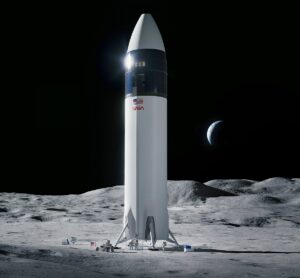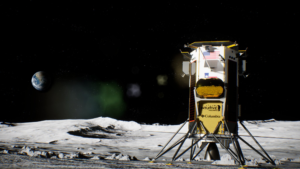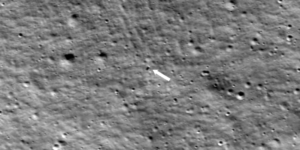
What Exactly Went Wrong During Odysseus’s Landing?
A few days ago on the 22nd the Intuitive Machines lunar lander attempted to touchdown on the lunar south pole. This was quite a big deal as not only was it a private company responsible but this was also the first U.S. lunar landing attempt in over 50 years. However, what was initially reported by the company as a successful and upright landing, has since changed with new information.
We now know that during its final approach toward the surface, they believe one of its legs got caught in a hole in the ground tipping the entire lunar lander onto its side. It now is horizontal with some of its solar panels now sideways rather than vertical attempting to gather energy. Despite this mishap, teams at Intuivitve Machines and NASA believe it can still complete part of its science mission. Here I will go more in-depth into the landing error, how it happened, what this means for the rest of the mission, and more.
Sideways Landing

On the 22nd, after the lander had made it to the Moon’s orbit, a few problems started to arise. First, they reported that team members discovered that Odysseus’ laser rangefinders, which the lander uses to determine its altitude and horizontal velocity, weren’t working properly. As a result, they decided to switch over to an experimental NASA instrument that Odysseus was carrying, pressing it into service for vital landing operations. Obviously, this is far from ideal and not the original plan.
Despite these complications, it managed to work to the point where the lander made contact with the surface of the Moon in one piece. However, at the time of landing, teams weren’t quite sure if the lander had managed to successfully touch down. Views inside the control room showed different team members scanning monitors and viewing lander data before they eventually announced that it had touched down on the Moon. Soon after the company even tweeted saying the lander was upright and starting to send data.
It wasn’t until yesterday on the 23rd, during a NASA briefing that we learned what actually happened to the lander. In reality, the lander was not at all upright but instead had tipped over on its side. The Intuitive Machines CEO was quoted saying, “We think we came down at about 6 mph down and 2 mph sideways (which he compared to walking speed) and caught a foot in the surface and the lander has tipped. We are getting sun from the side around the lander and we believe we have solar sun on the top deck. The majority of our payloads are all in view, and we are collecting science” he said. In other words, the lander which features 6 primary landing legs is thought to have gotten one stuck when the lander was still slightly moving in a sideways direction which forced it to tip over. The lander, which is on the taller side at 4.6 meters tall and 1.6 meters in diameter, was supposed to descend straight down without any lateral movement.
On top of that, during the press conference, the IM CEO showed exactly what he thought had happened using a toy model of the lander. He clarified that the blue object is what they believe is a rock and the top of the spacecraft landed on it creating a somewhat even surface. As far as why they announced that the lander was originally upright soon after landing, he had a few reasons. Here he said, “Yesterday we thought that we were upright, and the reason was that the tanks were reading gravity on the Moon and fill levels with residuals in the x direction. He went on to say, “But that was stale telemetry. When we worked through the night to get other telemetry down, in the z direction, we saw the residual tank quantities. And so that’s what tells us with fairly certain terms the orientation of the vehicle” he said.
As far as actual images of the event, so far the only ones that have been released include a pre-landing picture. Specifically, it is an image 125 miles (200 km) uprange from the intended landing site, at approximately about 6 miles (10 km) altitude. Unfortunately, one of the main ways they were planning to capture the landing attempt on camera is no longer an option. In this case, the lander was equipped with EagleCam, an instrument built by students at Embry-Riddle Aeronautical University (ERAU) that was designed to deploy from Odysseus about 100 feet (30 meters) above the lunar surface and photograph the craft’s touchdown from below.
However, due to the navigation complications that I mentioned prior, which required the uplink of a software patch, “the decision was made to power down EagleCam during landing and not deploy the device during Odysseus’ final descent,” said the ERAU’s director of news and media relations. He continued by saying, “However, both the Intuitive Machines and EagleCam teams still plan to deploy EagleCam and capture images of the lander on the lunar surface as the mission continues. The time of deployment is currently unknown. Stay tuned! More information will be released as soon as it becomes available” he said. The lander is equipped with other cameras and in the recent briefing, the IM CEO mentioned that they are hoping to get some images sometime this weekend and release them. As of right now, we still don’t have very much to show.
Impact On Payloads

With all this new information, the question now becomes what will happen to the rest of the mission now that the lander is on its side. In a Q&A at the end of the briefing, a question was asked about how the sideways orientation will affect the rest of the mission. The CEO responded, “Like I mentioned, we don’t have active payloads on Panel E, which I believe is facing the Moon. Therefore, the active payloads that need communications and we need to command are all exposed to the outside which is very fortunate for us. We do have antennae however that are pointed at the surface and those antennae are unusable for transmission to Earth. And so that really is a limiter in our ability to communicate and get the right data down so that we get everything that we need for the mission, and this is the most compromised.”
In fact, the only payload on Panel E facing the Moon is a static payload, an artwork provided by an artist. That at least is the current thought by the company who still has a number of unknowns. They also mentioned, “If you catch a foot, we might have fractured that landing gear and tipped over gently. The lander appears to be resting on a rock, elevating it slightly above the surface, based on the power it is generating; he said the foot could also be in a crevice.
Focusing back on the future of the mission, he then pointed out, “I was telling you before about the solar panel at the top deck, we had to angle that at about 30 degrees tilt up before landing on the south pole. Now we’ve tipped over and we don’t know the health of that solar panel” he said. There are other solar panels however they are no longer vertical which is not ideal. All things considered, they seem to be quite happy with the result even though the lander is on its side.
Taking a closer look at all the paylaods abroad also give a better idea of how they are affected by the sideways landing. In total there are 12 paylaods, 6 from NASA and 6 commercial. The first is from Columbia Sportswear who is testing a type of lining against the harsh conditions on the Moon. It specifically is used as for some panel covering which could have already gained valube information prior to and even after the landing. Next is the EagleCam that I mentioned prior. Since it wasn’t deployed during the descnet as planned, even though they still want to deploy it, the current positon of the lander could hinder that process. It will depend on exactly what side of the lander the cam is and whether or not teams still want to deploy it.
Next is the art which includes a number of sculptures called Moon phases. You then have ILO-X which includes a miniaturized dual-camera lunar imaging suite (one wide field and one narrow field). Its goal was to aim and capture some of the first images of the Milky Way Galaxy Center from the surface of the Moon, as well as performing other celestial astronomy. The sideways landing will definitely hinder this process but the camera can likely still view some of its original targets. The last two commercial payloads include a secure lunar repository and a data center which neither should be affected by the landing.
As for the NASA payloads, you have the RFMG or Radio Frequency Mass Gauge. This uses radio waves and antennae in Nova-C’s tank to measure exactly how much propellant is available. By now this tech has already been operating and gathering data even before the landing. If anything the sideways orientation could better test the system. Next is LN-1 or the Lunar Node 1 Navigation Demonstrator. This science instrument operated daily during the cruise phase as the landing date drew closer. The radio beacon is designed to support precise geolocation and navigation observations to orbiters, landers, and surface personnel, digitally confirming their positions on the Moon relative to other craft, ground stations, or rovers on the move. In other words, a primary part of its mission has already been completed.
Theres also the Stereo Cameras for Lunar Plume-Surface Studies or SCALPSS. This experiment was hoping to capture images of the effects of the lander’s engine plume as it interacted with the lunar surface while Odysseus was descending, and as the dust plume settles after the spacecraft lands. Even though its now sideways, during the landing it should have gathered its intended data and even after it was tipped over. You then have the Navigation Doppler Lidar for Precise Velocity and Range Sensing or NDL. NDL is a LIDAR-based (Light Detection and Ranging) sensor composed of an optical head with three small telescopes and a box with electronics and photonics. Its main purpose was to detect the distance from the ground during decent, something that’s already happened. Next is the Laser Retro-Reflector Array or LRA. LRA is a collection of eight approximately half-inch retro-reflectors – a unique collection of mirrors that is used for measuring distance – mounted to the lander. If IM is right about the landers orientation and Panel E facing the Moon, this experiment could still provide valube information as it would be exposed. Finally you have the Radio Observations of the Lunar Surface Photoelectron Sheath or ROLSES. This tech is planning to measure the electron plasma environment on the lunar surface among other actions. Its expected to be fine and still able to operate.
According to Intuitive Machines, the lander was not designed to withstand the lunar night and requires sunlight upon its solar panels to power its operations. For reference, a full lunar day is 28.3 Earth days long, with 14.15 Earth days of sunlight, and 14.15 Earth days of darkness. Since the lander touched down on the Moon at what could be called the lunar noon-time, approximately seven Earth days after the lunar sunrise for that lunar day, the lander will only have approximately 5 remaining Earth days of sunlight left before the next lunar sunset. Accordingly, the Odysseus system has been programmed so that after seven days, once the sun has finally set over the landing site, it will fully and finally shut down. With this in mind, no matter the state of the lander it only has a limited amount of time left.
Conclusion
It turns out that the Odysseus lander is not upright but it actually tipped over. This is not ideal and in the coming days, we will learn more about its condition and how it affects the rest of the science mission. We will have to wait and see how it progresses and the impact it has on the space industry.



